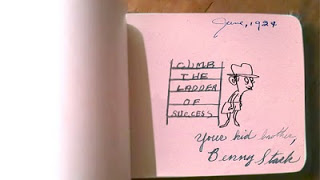
 Some more stills from my latest short, Grandpa Looked Like William Powell, which is decidedly (and unashamedly) not about sophisticated drawing nor full animation.
Some more stills from my latest short, Grandpa Looked Like William Powell, which is decidedly (and unashamedly) not about sophisticated drawing nor full animation.
At my book launch event at MoCCA, my friend, talented animator Stephen Mead, asked me if I had been a writer all my life. I remember being assigned a lot creative writing assignments in grammar school and high school and always feeling hopeful (at the start of each one) that I would do a good job and write the best essay or short story ever. But, it never seemed to happen. I never could write out the interesting ideas living inside my head. This went unchanged until I finally realized that you could write in your own voice.
As an animation professional I had a similar problem. I couldn’t easily put on paper what I imagined in my head or what I could observe with my eyes. I recently finished my third animated short in three years and of all the shorts I’ve made, these are the three of which I’m most proud, and especially so with my new film “Grandpa Looked Like William Powell.” I recently shared a link of this short with an animator friend of mine who is struggling for 12 years to make a single short film, and she asked me how I stay motivated and finish my films. I think the answer to this question is important because it’s instructive to examine what factors may lead to finishing or not finishing projects.
First of all, there’s nothing wrong with spending 12 years making a single film, nor is there anything wrong with making a sophisticated or complex film. I know of people spending even longer periods of time on films than 12 years, and who’s to say that when those films come out that it won’t have been worth every moment? So, the key is to make the film you want to make and play to your best chances of finishing it. I have the ability to stay focused enough to spend up to two years on a film, but now I prefer a more instant kind of film, one that doesn’t require slick or perfect production. Besides, why not leave the slick stuff to Pixar? So, now I work to make films that look like I made them, not by a sea of anonymous employees.
The animation production of my “Grandpa” short was finished in a month despite it being four minutes and twenty seconds long. This speed was enabled by my creative choices. By drawing right onto the cintiq there was no paper to scan in or process, and because my finished animation was only line art there was no characters to color in. By using live action footage in place of backgrounds there was no background art to create. And, the combination of line art and live action footage ensured that the natural shadows coming off the gutter of the book would spill right on to my character lines, helping them to feel sandwiched into the book’s pages and live alongside the original writing on the book’s pages. My feeling is that elimination (no BGs, no color, no storyboard) is a big part of creativity. I had remembered that Michael Sporn had used a similar technique by deciding to not storyboard the first half of his powerful film “Champaign.” I’m always keeping an ear out to hear how other people are working. You never know when you might want to borrow a technique or idea.
Because I wasn’t burdened with a complicated production, a creative approach came together in a very organic way. Four or five shots into the film I got the idea to always draw my Grandpa in a bathing suit and hat, even though an explanation for that choice doesn’t come until a minute into the film. This free wheeling way of working let me really get into character and get the right tone and motivation in each character’s actions. When my grandpa throws me his autograph book at the end of the film he does it as an after thought. Its a very casual and cavalier action, something that is in character for my Grandpa and true to our relationship. It would have been a big mistake to have him hand me the book in a careful and loving manner. None of this was storyboarded or planned out ahead of time. I just drew the scene and figured it out as I went. And, while there was still a lot of thought in this method, it wasn’t overdone or over planned. Slick and complicated productions require careful planning and a proper pipeline, but my little short required only a personal touch and little more.
World famous and oscar-nominated Cordell Barker penned one of my favorite quotes in my new book “…the better the drawer, the more the drawing seems to be of the most importance. But I think that it’s the least important of all [aspects].” I’m in firm agreement with Cordell, especially since I can’t make sophisticated drawings. So, there’s no way that perfect drawings could ever be the point of one of my films. What a liberating idea for any level of artist. Imagine if you gave yourself permission to draw what felt right versus what had to be slick or polished? Cordell went on to conclude, “The simpler the design, the more auteur the feel. The more slick and sophisticated the attempt, the less of a personal brand.”
We all have different talents to exploit and different weaknesses to overcome. The key to success is figuring out how to make it all work for you.

